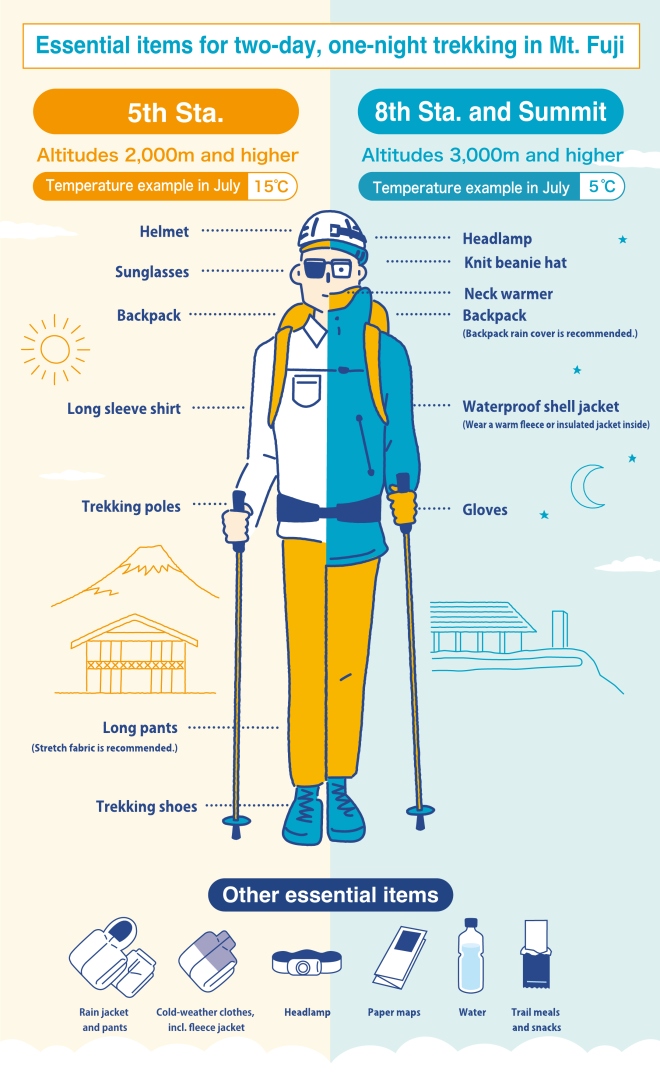
Equipment


Rainwear, winter clothing, headlamps, and maps are essential!
Be sure to check your equipment before departure. Old equipment may be broken so check the condition before departure.
The weather is changeable suddenly on Mt. Fuji, which is close to 4,000 m, and it may take longer to descend. Prepare proper equipment as shown below.
| Shoes | Climbing boots, trekking shoes High-cut and with hard soles. Mt. Fuji consists of volcanic gravel. If you are wearing low-cut shoes, gravel will easily get into your shoes. Other shoes with thin soles such as sneakers will have holes. Sandals are not appropriate. |
| Rain gear | Separate type The wind is very strong on Mt. Fuji, and highly durable climbing rain gear is recommended. Umbrellas and inexpensive vinyl raincoats may be damaged. |
| Winter Clothing |
Fleece, sweater, down jacket, arctic cap, gloves, neck warmer, etc.
The summit can be below zero Celsius even in midsummer. Rain and wind makes you feel colder. Prepare proper winter clothing. |
| Light | Even if you don't plan on being out and about until late at night, be sure to bring a headlamp. It gets dark rapidly after sunset. Headlamps are necessary to keep your hands free when you climb with your hands on the rocks. Bring spare batteries with you. (Don't forget to check the lights beforehand.) |
| Backpack | If you are staying at a mountain hut, a backpack with a capacity of about 30L is recommended. It is important to use a bag that leaves both hands free. |
| Underwear | Quick-drying Choose quick-drying underwear made of synthetic fibers, etc. Cotton is hard to dry when it gets wet, which will take away your body heat. Jeans are especially hard to dry, and they are not suitable. |
| Socks | We recommend synthetic fibers or wool as the material. This is necessary for long periods of walking on rocky and gravel mountain trails. |
| Gloves | It is necessary to protect your hands when climbing rocks or in case of an unexpected falling over. If you have children with you, don't forget to bring kid gloves. |
| Hat | A hat is necessary to prevent heatstroke and sunburn. Once out of the forest, the trail is no longer shaded and climbers are exposed to strong sunlight. |
| Water | 1-2 liters of water (Sold at mountain lodges) Altitude sickness is one of the most common reasons for giving up climbing. It is important to drink water frequently during your climb to prevent it. There is no water station or running water on Mt. Fuji. Bring your own drinking water or buy it at mountain lodges. |
| Energy foods | Easy-to-eat snacks, etc. Sweets are effective for recovering from fatigue. Chocolate, nuts, cookies, candy, and other high-calorie foods are recommended. Cheese, salami, and other items, that can be supplemented with salt, are also recommended. |
| Trash Bag | To take your trash back home with you When you climb a mountain, be sure to prepare trash bags to take your trash back home with you. It is strictly prohibited to leave trash in toilets. |
| Money | Cash: Credit card is not usually accepted at mountain huts Small Change: contribution for toilet Mainly small change Bring cash (small change) to pay for the accommodation fee for the mountain lodge, the purchase of drinking water, toilet usage tips, etc. Credit cards are not accepted at many mountain lodges. |
| Others | Cap/hat, sunglasses, sunscreen, Ultraviolet rays are strong on Mt. Fuji. Ultraviolet rays can cause fatigue, so sun protection is important. Map Trails are not a single road. Check where you are on the map while walking. Walking poles Mountain climbing is a sport that puts a lot of strain on the legs. Walking poles can reduce the strain on the knees. They are especially effective for the descent. Tape, string, rope, etc. |
| Hard Hat, Helmet |
Bring a helmet with you in case of a sudden eruption. Helmets will protect your head from falling rocks and injury caused by falls. *[Yoshida Trail] Helmet free lending service at Mt. Fuji 6th station Mt. Fuji Safety Guidance Center. Quantities are limited. Pay deposit 2000yen/per Helmet. Deposit will be returned only when borrowed helmets are no damaged and lost. *[Fujinomiya Trail] Mt. Fuji General Information Center at 5th station provides Helmet free lending. No deposit but need to fill out a form. |
| Dust mask | Dust mask can also fend off dust when you are trekking down the descent trails, which become dusty. |
| Dust goggles | Dust goggle can also protect your eyes against dust on the descent trails. |



